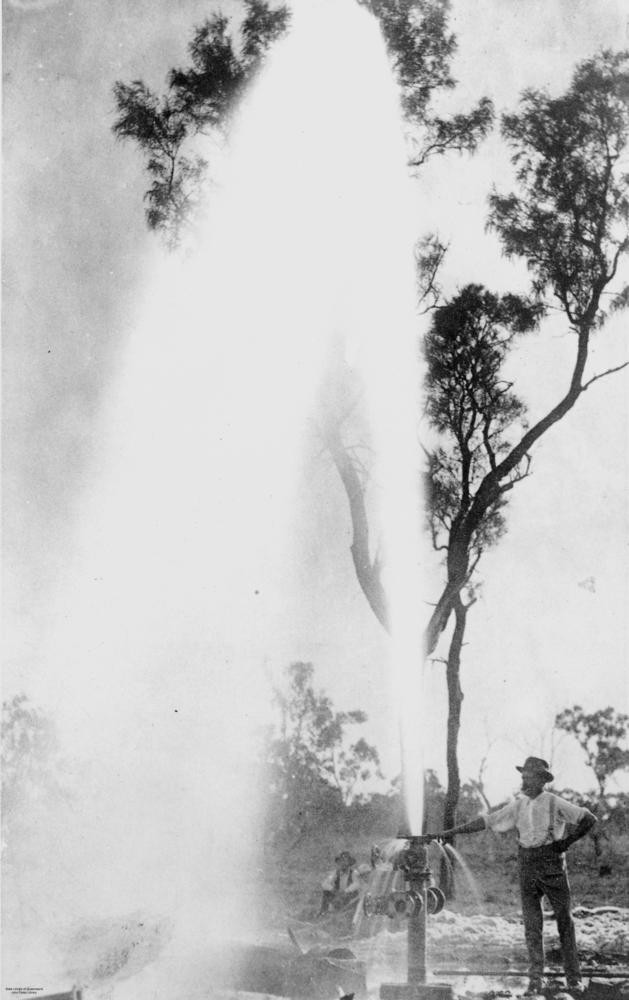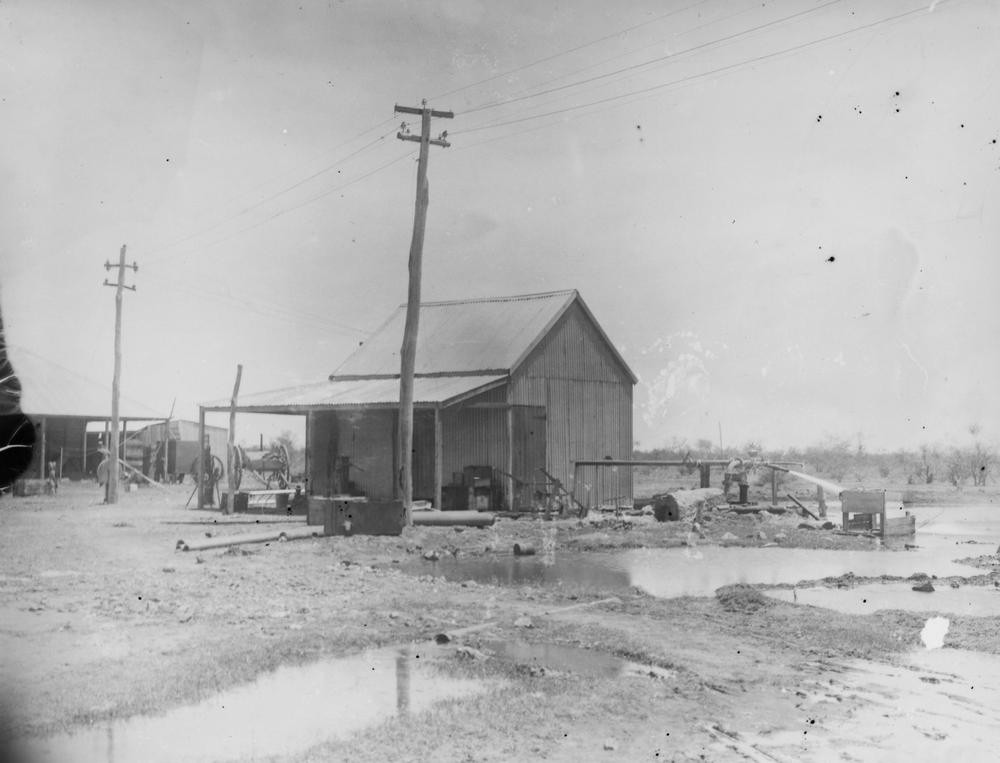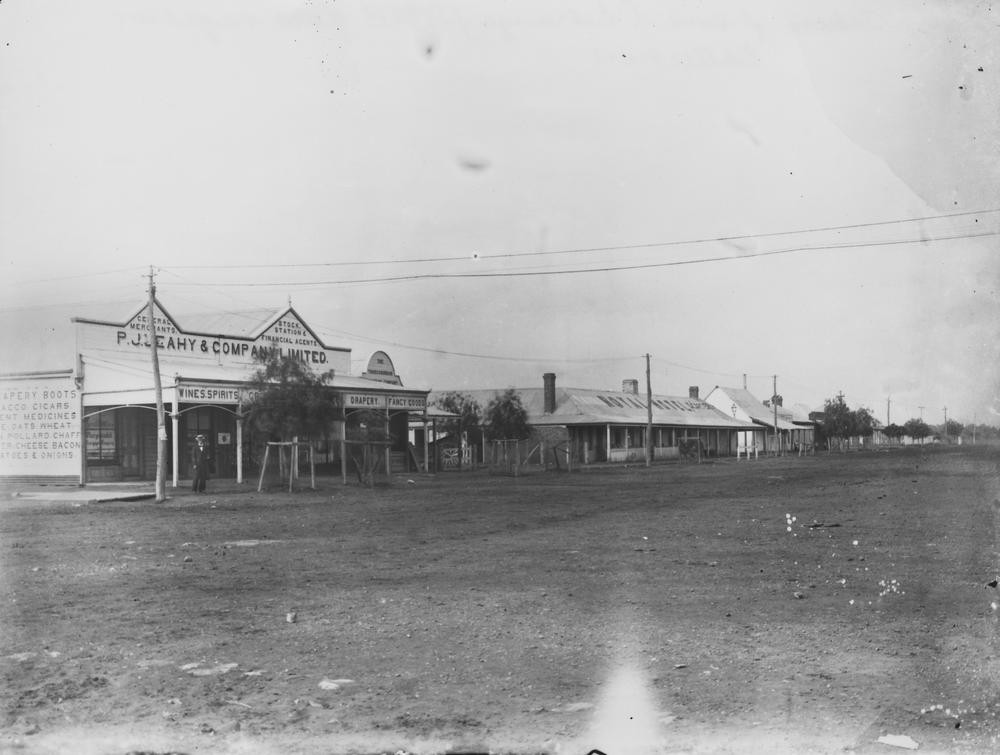Drilling for electricity? Thargomindah's hydroelectric dream 1898
By Simon Miller, Library Technician, State Library of Queensland | 13 June 2012
At the end of the 19th Century Thargomindah in the far south-west of Queensland was one of the few places in Australia that enjoyed the benefits of reticulated water and electric street lighting. How was it that this isolated community reveled in modern luxuries that much larger towns and cities would not enjoy for decades?
The answer lies in Thargomindah's location above the Great Artesian Basin. The Artesian Basin is an underground water resource in which large volumes of water are trapped in layers of permeable sandstone between layers of impermeable mudstone. The water can be millions of years old and is under considerable pressure. The Great Artesian Basin was first discovered when a bore was sunk near Bourke in New South Wales in 1878 and the discovery was repeated in bores in Queensland in the 1880s. Thargomindah's bore was drilled in 1893 and pipes were laid to provide reticulated water to the town in 1895.

Artesian bore in the Barcaldine District, Queensland, ca. 1894. Negative number: 109159
Around the same time an enterprising local by the name of Patterson obtained an electric generator powered by a steam engine and the idea of electricity caught on in the town, as described here in a 1929 article in the Brisbane Courier entitled An electric light romance.
The history of the Thargomindah Electric Light enterprise makes interesting reading. Thirty years ago a spirited townsman named Patterson, while on a business visit to Brisbane, purchased an electric light plant, and this he installed in his store. It was such a success that hotels and stores, applied to be connected. In time private dwellings were seeking the same privilege; indeed, there was such a demand for the light that the Bulloo Shire Council decided to purchase the plant. This was done, and with many additions it was duly installed in the bore area, and worked by bore water power. In those days electrical engineers were not readily found in the Great South-west, and a contractor in Brisbane was invited to undertake the work. He offered to do it for, £800. Not having a credit balance-and in those days rates did not amount to much in the year-the expenditure of £800 required a lot of thinking about. In those days, too, shire councillors were more or less personally responsible for public moneys, and they did not dare to play ducks and drakes with the public finances, as is sometimes done in these days of extraordinary expenditure and borrowing, and marvellously little, if any, thinking! The Bulloo councillors were still thinking hard, when the leading black-smith of the town, and a very clever mechanic, decided to put in his tender of £160. The councillors promptly accepted it, and in a few months the electric plant was installed, electric light was burning brightly in the town, and the work had been done on the job, amply attesting the skill of the local "engineer," who, for his ability, was appointed in charge of the plant, and for many years ran it most successfully. The plant is still in excellent working order.

Power station for hydro-electric scheme at Thargomindah, Queensland, ca. 1898 Negative number: 39213
The project was completed in 1898. It is claimed that this made Thargominda the just the third town in the world to be powered by hydroelectric power generated from an artesian well. I have not been able to verify this claim but Thargominda was certainly one of the first towns in Queensland to have electric street lighting, probably the first in Australia with hydroelectric power from artesian water and unique in enjoying the benefits of both reticulated water and hydroelectric street lighting. The effect of this new lighting system is described in an article from the Brisbane Courier of April 1 1898.
A successful concert in aid of the hospital was held last night. Electric wires from the artesian bore, a mile beyond the town, were attached to the town wires yesterday, and the hall in which the concert was held was brilliantly lighted by electricity. The light was beautifully clear and uniform, and everyone present pronounced the light to be a great success. The Cunnamulla representatives on the Rabbit Board were greatly pleased, and stated that Cunnamulla would probably decide to purchase an electric lighting plant soon. The electric lighting of Thargomindah will be finished in about three weeks.

Main Street, Thargomindah, ca. 1904 Negative number: 39165
Thargomindah’s power supply was carried to the town by overhead wires. This was illegal under the Queensland Electric Light and Power Act of 1896, because of the potential danger of fallen wires. In 1898, Government Electrician John Hesketh reported to Cabinet that the scheme would not be commercially viable if underground lines were to be used and a variation to the Law was introduced, and accepted, which allowed the use of overhead wires. Lighting for Thargomindah’s homes and streets was only provided for a restricted period – from 5.30pm to 11.30pm daily. This method of electricity supply continued until 1951 when the installation of diesel generators allowed a continuous supply.
Simon Miller - Library Technician, State Library of Queensland
Comments
Your email address will not be published.
We welcome relevant, respectful comments.